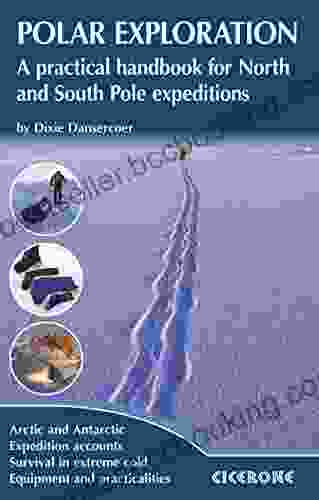Practical Handbook for North and South Pole Expeditions Techniques: The Ultimate Guide to Planning and Executing a Safe and Successful Expedition

The Arctic and Antarctic are two of the most challenging and unforgiving environments on Earth. Extreme weather conditions, treacherous terrain, and dangerous wildlife can make even the most experienced explorers vulnerable. That's why it's essential to be well-prepared before embarking on an expedition to either of these polar regions.
The Practical Handbook for North and South Pole Expeditions Techniques is the definitive guide to planning and executing a safe and successful expedition to the Arctic or Antarctic. With over 300 pages of expert advice and practical tips, this handbook covers everything you need to know, from choosing the right equipment and supplies to dealing with extreme weather conditions and polar bears.
Whether you're a seasoned adventurer or a first-time explorer, this handbook is an essential resource for anyone planning an expedition to the ends of the earth.
4.4 out of 5
| Language | : | English |
| File size | : | 3799 KB |
| Text-to-Speech | : | Enabled |
| Screen Reader | : | Supported |
| Enhanced typesetting | : | Enabled |
| Word Wise | : | Enabled |
| Print length | : | 192 pages |
The first step in planning any expedition is to define your goals and objectives. What do you want to achieve during your expedition? Are you interested in scientific research, adventure, or simply experiencing the beauty of the polar regions?
Once you have defined your goals, you can start to research the different options available to you. There are a number of different ways to travel to the Arctic and Antarctic, and the best option for you will depend on your budget, time constraints, and experience level.
If you're planning to travel to the Arctic, you can choose from a variety of options, including:
- Cruise ships: Cruise ships offer a comfortable and convenient way to see the Arctic. They typically depart from major ports in Europe and North America, and they offer a variety of itineraries to choose from.
- Expedition yachts: Expedition yachts are smaller than cruise ships, and they offer a more intimate experience. They can access remote areas that are inaccessible to larger ships, and they often offer the opportunity to participate in hands-on activities, such as wildlife viewing and scientific research.
- Private charters: If you have a large budget, you can charter a private yacht or plane to take you to the Arctic. This is the most expensive option, but it also offers the most flexibility.
If you're planning to travel to the Antarctic, you can choose from a variety of options, including:
- Expedition ships: Expedition ships are specially designed to navigate the harsh conditions of the Antarctic. They offer a variety of itineraries to choose from, and they often include activities such as wildlife viewing, kayaking, and hiking.
- Icebreakers: Icebreakers are powerful ships that can break through thick sea ice. They are used to support scientific research and to transport supplies to research stations.
- Private yachts: As in the Arctic, you can also charter a private yacht or plane to take you to the Antarctic.
Once you have chosen your mode of transportation, you can start to plan your itinerary. It's important to factor in the time of year, the weather conditions, and the availability of supplies and support services.
You should also make sure to obtain the necessary permits and visas before you travel.
The equipment and supplies you need for your expedition will depend on the specific activities you plan to undertake. However, there are some essential items that every explorer should have, including:
- Clothing: Your clothing should be designed to keep you warm and dry in extreme weather conditions. It should also be durable and comfortable enough to withstand the rigors of travel.
- Footwear: Your footwear should be waterproof and provide good support. It should also be comfortable enough to wear for long periods of time.
- Sleeping bag: Your sleeping bag should be rated for the coldest temperatures you expect to encounter. It should also be lightweight and compressible so that it's easy to pack.
- Sleeping pad: Your sleeping pad will provide insulation from the cold ground. It should be comfortable and durable.
- Tent: Your tent should be able to withstand high winds and snow loads. It should also be lightweight and easy to set up.
- Food: You should bring enough food to last for the entire duration of your expedition. Your food should be high in calories and nutrients, and it should be easy to prepare and eat.
- Water: You should bring enough water to last for the entire duration of your expedition. You can also melt snow for water, but it's important to have a backup plan in case the weather conditions make it impossible to melt snow.
- First-aid kit: Your first-aid kit should contain a variety of supplies to treat minor injuries and illnesses.
- Repair kit: Your repair kit should contain a variety of tools and supplies to repair your equipment.
- Navigation equipment: You should have a map, compass, and GPS device to help you navigate.
- Communication equipment: You should have a satellite phone or other communication device to stay in contact with the outside world.
The Arctic and Antarctic are home to some of the most extreme weather conditions on Earth. Temperatures can drop below -50 degrees Celsius, and winds can reach speeds of over 100 miles per hour. It's important to be prepared for these conditions and to know how to stay safe in the event of a storm.
Here are some tips for dealing with extreme weather conditions:
- Stay informed about the weather forecast. Before you head out on your expedition, check the weather forecast and be aware of any potential storms.
- Dress appropriately. Wear layers of clothing to stay warm and dry. Make sure your outer layer is waterproof and windproof.
- Seek shelter in a sturdy building or tent. If you're caught in a storm, seek shelter in a sturdy building or tent. Stay away from windows and doors, and keep your head and neck covered.
- Stay hydrated. Drink plenty of fluids to stay hydrated. Avoid drinking alcohol, as it can dehydrate you.
- Eat warm foods. Eating warm foods will help you stay warm. Avoid eating cold foods, as they can lower your body temperature.
Polar bears are one of the most dangerous animals in the Arctic. They are large, powerful predators that can attack humans without provocation. It's important to be aware of the risks of polar bear encounters and to take steps to avoid them.
Here are some tips for dealing with polar bears:
- Be aware of your surroundings. Polar bears are often attracted to food and garbage. Be aware of your surroundings and avoid areas where polar bears are likely to congregate.
- Make noise. Polar bears are more likely to avoid humans if they can hear them coming. Talk, sing, or clap your hands to make noise and let polar bears know that you are present.
- Carry bear spray. Bear spray is an effective deterrent against polar bears. Carry bear spray with you at all times and know how to use it.
- If you encounter a polar bear, remain calm. Do not run or make any sudden movements. Slowly back away from the bear while making yourself as large as possible. If the bear charges you, use your bear spray or fight back with whatever you have available.
The Arctic and Antarctic are two of the most beautiful and challenging places on Earth. With the right planning and preparation, you can have a safe and successful expedition to these amazing regions.
The Practical Handbook for North and South Pole Expeditions Techniques is the definitive guide to planning and executing a safe and successful expedition to the Arctic or Antarctic.
With over 300 pages of expert advice and practical tips, this handbook covers everything you need to know, from choosing the right equipment and supplies to dealing with extreme weather conditions and polar bears.
Whether you're a seasoned adventurer or a first-time explorer, this handbook is an essential resource for anyone planning an expedition to the ends of the earth.
4.4 out of 5
| Language | : | English |
| File size | : | 3799 KB |
| Text-to-Speech | : | Enabled |
| Screen Reader | : | Supported |
| Enhanced typesetting | : | Enabled |
| Word Wise | : | Enabled |
| Print length | : | 192 pages |
Do you want to contribute by writing guest posts on this blog?
Please contact us and send us a resume of previous articles that you have written.
 Book
Book Novel
Novel Page
Page Chapter
Chapter Text
Text Story
Story Genre
Genre Reader
Reader Library
Library Paperback
Paperback E-book
E-book Magazine
Magazine Newspaper
Newspaper Paragraph
Paragraph Sentence
Sentence Bookmark
Bookmark Shelf
Shelf Glossary
Glossary Bibliography
Bibliography Foreword
Foreword Preface
Preface Synopsis
Synopsis Annotation
Annotation Footnote
Footnote Manuscript
Manuscript Scroll
Scroll Codex
Codex Tome
Tome Bestseller
Bestseller Classics
Classics Library card
Library card Narrative
Narrative Biography
Biography Autobiography
Autobiography Memoir
Memoir Reference
Reference Encyclopedia
Encyclopedia Donna Ball
Donna Ball Dr David E Roots Chapman
Dr David E Roots Chapman Dr N Rama Chandran
Dr N Rama Chandran Deby Adair
Deby Adair Dennis E Taylor
Dennis E Taylor Dirck Noordhoff
Dirck Noordhoff Dima Ghawi
Dima Ghawi Dr Terry Zachary
Dr Terry Zachary Dolly Chugh
Dolly Chugh Douglas Robert Brown
Douglas Robert Brown Delia Gray Durant
Delia Gray Durant Deborah Jiang Stein
Deborah Jiang Stein Dr William Cooke
Dr William Cooke Diego Footer
Diego Footer Donna Brazile
Donna Brazile Deirdre Dolan
Deirdre Dolan Dick J Reavis
Dick J Reavis Doris Pena Cruz
Doris Pena Cruz Domenica Di Piazza
Domenica Di Piazza Dina Jalowski
Dina Jalowski
Light bulbAdvertise smarter! Our strategic ad space ensures maximum exposure. Reserve your spot today!
 Dwayne MitchellFollow ·14.9k
Dwayne MitchellFollow ·14.9k Holden BellFollow ·6.4k
Holden BellFollow ·6.4k Ibrahim BlairFollow ·12.2k
Ibrahim BlairFollow ·12.2k Shawn ReedFollow ·8.8k
Shawn ReedFollow ·8.8k George R.R. MartinFollow ·8.9k
George R.R. MartinFollow ·8.9k Travis FosterFollow ·19.6k
Travis FosterFollow ·19.6k John MiltonFollow ·15.2k
John MiltonFollow ·15.2k W. Somerset MaughamFollow ·6.3k
W. Somerset MaughamFollow ·6.3k

 J.D. Salinger
J.D. SalingerThe Quintessential American Cook: A Culinary Journey with...
Prologue: The Man...

 Franklin Bell
Franklin BellIntroducing Romanticism: A Literary Guide to the Romantic...
Romanticism was a...

 Denzel Hayes
Denzel HayesThe Untold And Inspiring Story Of Eric Liddell Hero Of...
The Olympian Who Defied...

 Oscar Wilde
Oscar WildeDiscover the Enchanting Adventure of Arthur Woody and the...
Immerse Yourself in a World of Mystery,...

 Fernando Bell
Fernando BellAlibaba: The House That Jack Ma Built
The Rise of the Chinese E-Commerce Giant ...

 Leo Tolstoy
Leo TolstoyCrossing Continents: A History of Standard Chartered Bank
By John M. Smith Crossing...
4.4 out of 5
| Language | : | English |
| File size | : | 3799 KB |
| Text-to-Speech | : | Enabled |
| Screen Reader | : | Supported |
| Enhanced typesetting | : | Enabled |
| Word Wise | : | Enabled |
| Print length | : | 192 pages |












